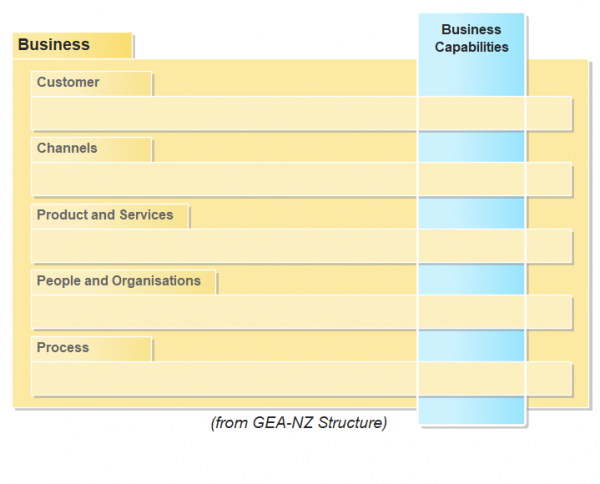GEA-NZ dimension: Business
The business dimension is one of the 4 core dimensions that represent the operational aspects of your enterprise architecture. It has 5 focus areas.
The business dimension is a representation of the business processes, products and services that deliver the outputs of the organisation.
Its 5 focus areas are customer, channel, products and services, people and organisations, and processes.
It emphasises customer centricity (putting the customer at the heart of what we do) and channel shift (finding the best ways to deliver service to your customers).
Reference taxonomy
To download the reference taxonomy for business, see: Reference taxonomies.
Relationships to other dimensions
| Dimension | Influence |
|---|---|
| Strategy, investment and policy | Informs strategy and investment by identifying business functions, customer segments and services, and the organisational resources that support them. |
| Governance and performance | Helps identify potential metrics for service performance and customer needs, and gives structure to analyse business performance, for example, cost-to-serve. |
| Standards | Sets out the business domains in which standards are defined or required. |
| Identity, privacy and security | Identifies the business elements (customer segments, services) that require security and privacy protection, and the business requirements for identity and access management across channels. |
| Data, information and analytics |
Sets the business requirements for data and information, and identifies potential duplication and gaps. Supports effective use of the data within the data system aligned to the outcomes. |
| Application and software services | Sets the business requirements for application and software services across customer segments, channels and automated business processes. |
| Infrastructure | Sets the business requirements for infrastructure, including location dependencies, capacity forecasting and potential sharing opportunities and constraints. |
Five focus areas of the business dimension

Detailed description of diagram
The Business dimension has 5 focus areas:
- Customer
- Channels
- Product and Services
- People and Organisations
- Process.
The business capabilities of an organisation depends on all these focus areas in the business dimension, as well as the other 3 core dimensions, working together.
1. Customer
2. Channel
3. Products and services
4. People and organisations
5. Process
Utility links and page information
Last updated

